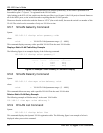
IES-1000 User’s Guide
IEEE 802.1Q Tagged VLAN Commands 9-1
Chapter 9
IEEE 802.1Q Tagged VLAN Commands
This chapter generally describes the IEEE 802.1Q Tagged VLAN and associated CI Commands.
9.1 Introduction
The IEEE 802.1Q Tagged VLAN allows your network module to deliver tagged/untagged packets to and from its
ports. The standard gives the network module the ability to recognize VLAN-aware and VLAN-unaware devices
and automatically strips tagged packets destined for ports that would normally drop tagged packets.
9.2 IEEE 802.1Q Tagged VLAN -Tags
When a LAN bridge receives a packet from a workstation, the VLAN from whence it came must be known so the
bridge may respond, if necessary, to the source of the packet. This is accomplished by tagging. There are two kinds
of tagging:
1. Explicit Tagging
• A VLAN identifier is added to the packet header that identifies the source VLAN.
2. Implicit Tagging
• The MAC (Media Access Control) number, the port or other information is used to identify the source of a
VLAN packet.
The IEEE 802.1Q Tagged VLAN uses both explicit and implicit tagging.
9.3 VLAN-Aware/VLAN-Unaware Devices
It is important for the LAN bridge to determine what devices are VLAN-aware and VLAN-unaware so that it can
decide whether to forward a tagged packet (to a VLAN-aware device) or first strip the tag from a packet and then
forward it (to a VLAN-unaware device).
9.4 Filtering Databases
A filtering database stores and organizes VLAN registration information useful for routing packets to and from a
LAN bridge. A filtering database consists of a static entries (Static VLAN or SVLAN table) and dynamic entries
(Dynamic VLAN or DVLAN table).
9.4.1 Static Entries (SVLAN Table)
Static entry registration information is added, modified and removed by management only.


















